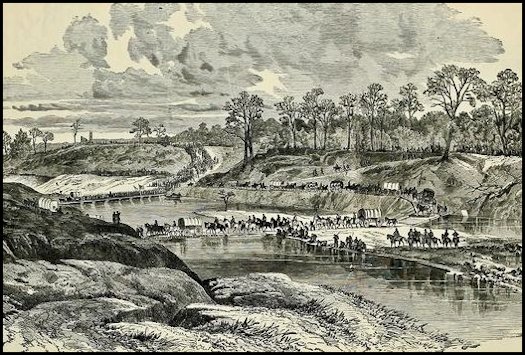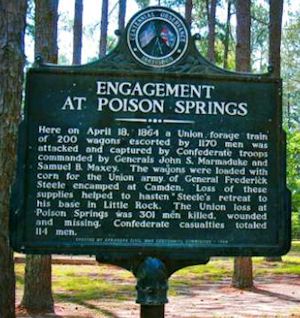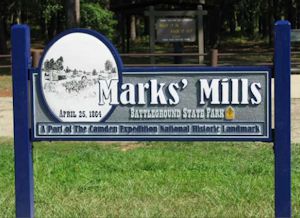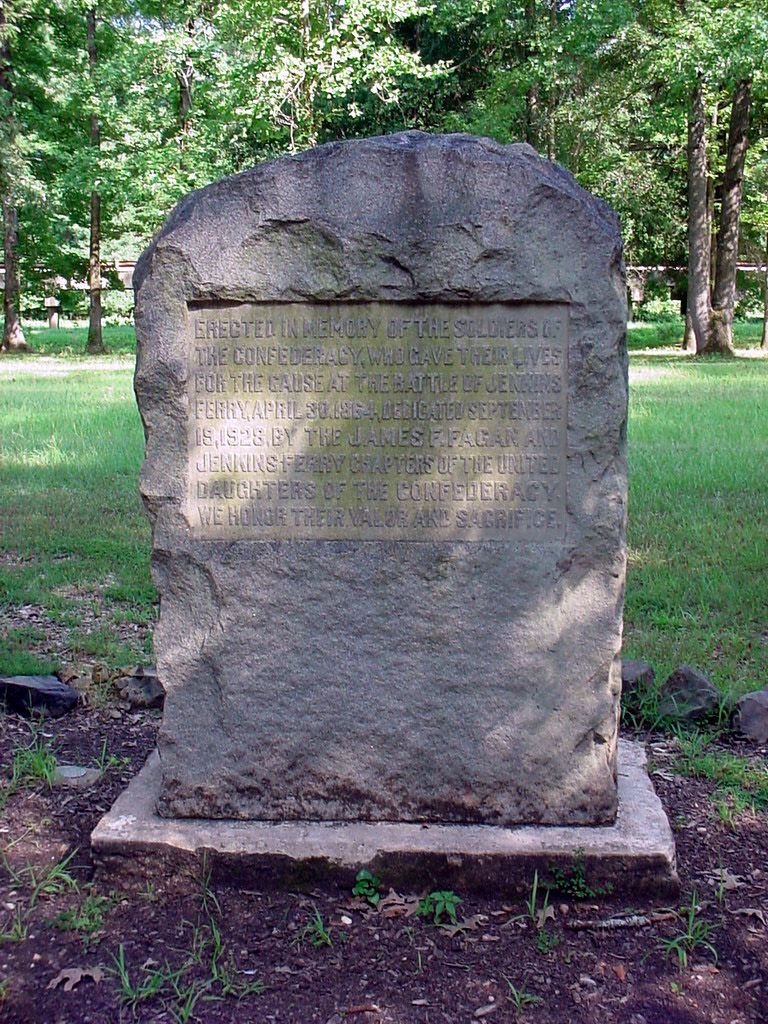Clark Co., Wisconsin Civil War Veteran's Index
**********************************************************************************
The Red River Campaign
[Clark Co., WI Home] [ Veteran's Library Home]
BATTLE OF POISON SPRING--BATTLE OF MARKS--BATTLE OF JENKINS FERRY--JENKINS FERRY PHOTOS & MEMORIALS
|
On March 10, 1864, the Union army began the Red River Campaign, (sometimes known as the Red River Expedition). In Washington, Union strategists decided the occupation of east Texas and control of the Red River would separate Texas from the rest of the Confederacy because it was the source of much needed guns, food, and supplies for Confederate troops. It was a Union failure, characterized by poor planning and mismanagement and not a single objective was fully accomplished. |
Map of the Red River Expedition Route

Steele followed a route which roughly parallels today's Interstate 30. His Union forces crossed the Ouachita River at Rockport (near where the Interstate crosses the river at Malvern) and continued southwest, toward Texas.
Steele's army first encountered heavy resistance at the crossing of the Little Missouri River where a bloody affair took place between Steele's leading division and 3,000 Confederate dismounted cavalry. Further south on Prairie De Ann, near Prescott, the entire Confederate force dug in. A day and a half of hard fighting was needed to dislodge the outnumbered Rebels.
The fighting at Prairie De Ann slowed Steele, and spring rains had begun. The dirt roads turned into a quagmire. After two weeks of marching Steele had covered only 70 miles, and Confederate resistance was strengthening, particularly around Washington, the Confederate State Capital.
General Steel decided to alter his plans and turn east toward Camden instead of proceeding directly to Shreveport.
His army camped at White Oak Creek, 18 miles west of Camden on the night of the 12th; then, after a 2 hour skirmish, marched toward Camden. The Federals entered the city with little difficulty on April 13, 1864.
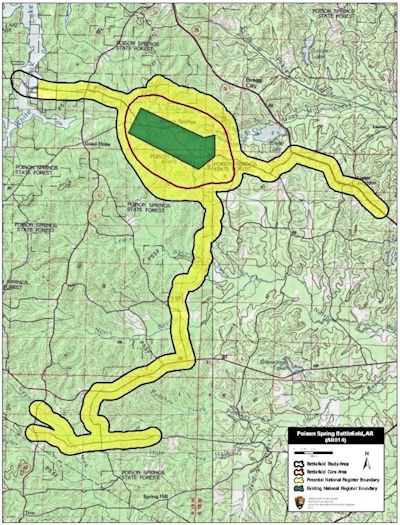 |
Three Civil War battles took place in south central Arkansas in the spring of 1864 as part of the Union Army’s Red River Campaign. The sites of these skirmishes – Poison Springs, Marks’ Mills, and Jenkins Ferry – and the 1836 Courthouse at Historic Washington State Park, which served as Arkansas’s Confederate capital, comprise the Red River Campaign National Historic Landmark. |
Steele's army included some 13,000 men, 9,000 horses and mules, 800 wagons, and 30 pieces of artillery. Supplying this army was proving to be a major problem. Steele later wrote that his supplies were nearly exhausted and so was the country. With men on half-rations for almost three weeks, it was almost impossible to enforce the commander's orders against unauthorized foraging.
On April 17, a train of 198 wagons was sent westward along the Upper Washington Road to collect corn and other foodstuffs. After loading wagons with corn, they camped 18 miles west of Camden. At sunup they began the march to Camden. Soon, they received reinforcements bringing the total force to 875 infantry (including the First Kansas Colored), 90 cavalry troopers and a four gun battery of artillery including two mountain howitzers, and two rifled cannon.
The Confederates, observing this movement, gathered some 3100 cavalry and eight cannon under Brigadier Generals Samuel B. Maxey and John S. Marmaduke. The enemy was met about 14 miles west of Camden at a place known as Poison Spring. The Confederates under Maxey blocked the Union advance and together he and Marmaduke attacked the front and south flank of the long forage train.
Several times the Federals tried to make a stand, only to be pushed back beyond the stalled train. After a fierce battle, including a furious charge by a regiment of Confederate Choctaw Indians, the Federals Broke in rout and were pursued for about two miles.
(The train was stalled along present-day Highway 70 on the south side of the state park. Fighting took place along both sides of the road.)
The Confederates captured the four cannon, complete with limbers and caissons, 170 wagons (the others being burned) and teams, took over 100 prisoners, and buried 181 Federal troops. According to a Southern officer, the wagons contained: Corn, bacon, stolen bed quilts, women's and children's clothing, hogs, geese and all the et ceteras of unscrupulous plunder.
301 Union soldiers were listed as killed or missing. Additionally, the loss created much indignation in the Union camp as well as aggravating the critical supply situation. Confederate losses were relatively small with 111 killed, wounded or missing.
The victory at Poison Spring along with the arrival of General E. Kirby Smith with three infantry divisions, and the report of the defeat of Union General Banks in Louisiana, raised Confederate hopes that they could cut off the supply lines and capture the entire Union Army.
 |
The Battle of Marks' Mills (April 25, 1864), also known as the Action at Marks’ Mills, was fought in present-day Cleveland County, Arkansas, during the American Civil War. Confederate Brigadier-General James F. Fagan, having made a forced march, attacked a train of several hundred wagons, guarded by a brigade of infantry, 500 cavalry, and a section of light artillery under command of Lieutenant-Colonel Francis M. Drake of the 36th Iowa, on its way from Camden to Pine Bluff for supplies. Wikipedia |
On April 20, a Union supply train from Pine Bluff arrived with 10 days; half-rations. On April 23, Confederate General Shelby crossed the Ouachita River to raid Union supply routes. The following day General Fagan learned that the Union supply train had left Camden under heavy guard, returning to Pine Bluff.
Fagan immediately selected a crack force of four brigades of cavalry and set off to intercept this prize. After a forced march of 52 miles, he crossed the Ouachita River at Moro Bay and headed north toward the junction of the Camden, Mount Elba and Pine Bluff roads (near the present junction of Highways 8 and 97 east of Fordyce).
The Union train included 240 government wagons and a number of private vehicles. It was guarded by three full regiments of infantry, 240 cavalry, and 4 pieces of artillery, in all some 1600 men, not including the First Iowa Cavalry which remained out of the battle.
Using tactics similar to those employed at Poison Spring, the Confederates blocked the Union advance, then, around 9:30 AM, attached the flank of the wagon train. The battle lasted 5 hours with the main unit of Confederates entering the battle dismounted and in piecemeal order, then the mounted Missourians charged from the north and mounted Arkansans from the south, sealing the fate of the Federal force. The Confederates successfully subdued the two lead Union regiments, then the rear guard and finally scattered the 500 veterans of the 1st Iowa who were marching a few miles behind the main column en route home on furlough.
About 1600 Union troops were engaged in battle against 2500 Confederates. Union losses could not have been less than 1300, the majority being captured. Southern losses were fewer then 500, including those slightly wounded. The victors found themselves with the entire train, some 1500 horses and miles, private vehicles, ambulances, four guns and valuable official reports concerning Steele's army.
On April 30, 1864, the Yankee Army held off a Confederate attempt to cut them off at Jenkin’s Ferry on the Saline River (south west of Little Rock).
In Camden, General Steele had to decide what was to be done before his command was immobilized by a breakdown in transportation and the consumption of his few remaining supplies. There seemed to be but one alternative to starvation and capture – an immediate retreat to Little Rock.
Early on April 26, 1864, Steele slipped out of Camden toward Little Rock. He chose to follow the Camden Trail which crossed the Saline River at Jenkins’ Ferry. The road was built before 1836 and served as one of the five main or “trunk roads” in Arkansas.
By 9 AM on April 27, upon learning that Steele had left Camden, the Confederate Army, under Generals E. Kirby Smith and Sterling Price, occupied the city and headed north after the Union column. If a Confederate force could get ahead of Steele and cut him off before he reached the Jenkins’ Ferry on the Saline River, perhaps the entire army could be destroyed.
On April 29, 1864, after three days of forced marching through heavy rains, Steele arrived in Sandy Springs (now Leola, Arkansas). Here he found formidable opposition, not from approaching Confederates, but from the flooded river which lay in his path.
The river was rising rapidly and Cox Creek was bank full. On either side of the swamp ridges of high ground provided a sense of security before plunging into the muddy road below.
Colonel Adolph Engleman, a Union brigade commander, described the
area in his diary:
“The ground, with the exception of an open field near the road, was a majestic forest growing out of a swamp which was very difficult to pass through on horseback, the infantry being most of the time in water up to their knees.”
It was into this swamp that Steele’s ill-fated wagon train was forced to enter. An India rubber pontoon bridge was set up at the ferry site and the army began to cross, one wagon at a time. Because of the heavy weight of the wagons and the poor condition of the road, the train bogged down in the mire stretching all the way from Sandy Springs to the river. Despite this difficulty, Steele managed to get his cavalry, artillery and most of his wagons across the Saline River by 8 AM. It was at this point that the Confederates arrived on the scene.
Steele immediately sent his men back down the Camden Trail to the rear of the slowly moving train to engage the enemy. The Battle of Jenkins’ Ferry had begun.
Steele’s rear guard collided with the Confederates at Jiles Farm about 2 miles from Jenkins’ Ferry. The Confederates launched a series of violent but piecemeal attacks along the entire Federal line. As the train slowly moved across the pontoon bridge at Jenkins’ Ferry, the battle moved from field to field along the Camden Trail toward the Saline River.
It was in the Jiles, Cooper and Kelley fields that both sides sustained most of their casualties. Generals as well as privates fell on both sides. Confederate Brigadier General William R. Scurry fell on the field. Colonel and acting brigade commander Horace Randal, Colonel Hiram Lane Grinstead of the 3 3rd Arkansas Infantry, and Union General Samuel A. Rice were mortally wounded.
|
|
|
|
|
|
Enlarge the Picture====> |
|
**Information is from Arkansas State Parks “The Red River Campaign in Arkansas” pamphlet EXH SHP 2-13-89. Used with permission.
For more information see "Steele's Retreat From Camden and the Battle of Jenkins' Ferry", by Edwin C. Bearss and "The Red River Campaign; Politics and Cotton in the Civil War", by Ludwell H. Johnson.
[Clark Co., WI Home] [ Veteran's Library Home]
|
© Every submission is protected by the Digital Millennium Copyright Act of 1998.
Show your appreciation of this freely provided information by not copying it to any other site without our permission.
Become a Clark County History Buff
|
|
A site created and
maintained by the Clark County History Buffs
Webmasters: Leon Konieczny, Tanya Paschke, Janet & Stan Schwarze, James W. Sternitzky,
|
